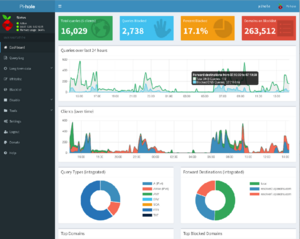Software:Pi-hole
 Screenshot of the AdminLTE web interface for Pi-hole | |
| Developer(s) | Pi-hole, LLC[1] |
|---|---|
| Initial release | June 15, 2015 |
| Repository | github |
| Written in | Bash, C (optional DNS server FTLDNS), PHP, CSS (optional web console) |
| Operating system | Linux |
| Licence | European Union Public Licence |
| Website | {{{1}}} |
Pi-hole is a Linux network-level advertisement and Internet tracker blocking application[2][3] which acts as a DNS sinkhole[4] and optionally a DHCP server, intended for use on a private network.[1] It is designed for low-power embedded devices with network capability, such as the Raspberry Pi,[2][5] but can be installed on almost any Linux machine.[4][6]
Pi-hole has the ability to block traditional website advertisements as well as advertisements in unconventional places, such as smart TVs and mobile operating system advertisements.[7]
History
The Pi-hole project was created by Jacob Salmela as an open source alternative to AdTrap[8][9] in 2014[10] and was hosted on GitHub.[11] Since then, several contributors have joined the project.[10]
Features
Pi-hole makes use of a modified dnsmasq called FTLDNS,[12] cURL, lighttpd, PHP and the AdminLTE Dashboard[13] to block DNS requests for known tracking and advertising domains. The application acts as a DNS server for a private network (replacing any pre-existing DNS server provided by another device or the ISP), with the ability to block advertisements and tracking domains for users' devices.[7] It obtains lists of advertisement and tracking domains from a configurable list of predefined sources, and compares DNS queries against them. If a match is found within any of the lists, or a locally configured blocklist, Pi-hole will refuse to resolve the requested domain and respond to the requesting device with a dummy address.[14]
Because Pi-hole blocks domains at the network level, it is able to block advertisements, such as banner advertisements on a webpage, but it can also block advertisements in unconventional locations, such as on Android, iOS and smart TVs.[7]
Using VPN services, Pi-Hole can block domains without using a DNS filter setup in a router. Any device that supports VPN can use Pi-Hole on a cellular network or a home network without having a DNS server configured.[15]
The nature of Pi-hole allows it to also block website domains in general by manually adding the domain name to a blocklist. Likewise, domains can be manually added to an allowlist should a website's function be impaired by domains being blocked. Pi-hole can also function as a network monitoring tool,[16] which can aid in troubleshooting DNS requests and network faults.[6] Pi-hole can also be used to encourage the use of DNS over HTTPS for devices using it as a DNS server with the cloudflared binary provided by Cloudflare.[17]
Difference from traditional advertisement blockers
Pi-hole functions similarly to a network firewall, meaning that advertisements and tracking domains are blocked for all devices behind it, whereas traditional advertisement blockers only run in a user's browser, and remove advertisements only on the same machine.[6][18]
See also
- Ad blocking
- Online advertising
References
- ↑ 1.0 1.1 "Pi-hole®: A black hole for Internet advertisements" (in en-US). https://pi-hole.net/.
- ↑ 2.0 2.1 "Turn A Raspberry Pi Into An Ad Blocker With A Single Command" (in en). Lifehacker Australia. 2015-02-17. https://www.lifehacker.com.au/2015/02/turn-a-raspberry-pi-into-an-ad-blocker-with-a-single-command/.
- ↑ "Adblock Everywhere: The Raspberry Pi-Hole Way" (in en-US). MakeUseOf. https://www.makeuseof.com/tag/adblock-everywhere-raspberry-pi-hole-way/.
- ↑ 4.0 4.1 "pi-hole/pi-hole" (in en). https://github.com/pi-hole/pi-hole.
- ↑ "Pi-hole hardware kit" (in en-US). 2018-05-07. https://uk.pi-supply.com/products/pi-hole-kit-network-wide-ad-blocker.
- ↑ 6.0 6.1 6.2 "Seven Things You May Not Know About Pi-hole" (in en-US). Pi-hole®: A black hole for Internet advertisements. 2017-05-12. https://pi-hole.net/2017/05/12/seven-things-you-may-not-know-about-pi-hole/.
- ↑ 7.0 7.1 7.2 Pounder, Les (2021-08-01). "How to Block Ads Network-Wide With Pi-hole on Raspberry Pi". Tom's Hardware. https://www.tomshardware.com/how-to/set-up-pi-hole-raspberry-pi. Retrieved 2023-05-17.
- ↑ "Block Millions Of Ads Network-wide With A Raspberry Pi-hole 2.0" (in en-US). Jacob Salmela. 2015-06-16. https://jacobsalmela.com/2015/06/16/block-millions-ads-network-wide-with-a-raspberry-pi-hole-2-0/.
- ↑ "Pi-hole: A Raspberry Pi Ad-Blocker with DNS Caching (Ultra-fast)" (in en-US). Jacob Salmela. 2014-06-11. https://jacobsalmela.com/2014/06/11/raspberry-pi-block-ads-adtrap/.
- ↑ 10.0 10.1 "pi-hole/pi-hole; Contributors" (in en). https://github.com/pi-hole/pi-hole/graphs/contributors.
- ↑ Jeffries, Adrianne (2018-05-10). "Inside the Brotherhood of the Ad Blockers". Bloomberg. https://www.bloomberg.com/news/features/2018-05-10/inside-the-brotherhood-of-pi-hole-ad-blockers.
- ↑ telekrmor (2018-02-22). "FTLDNS: Pi-hole's Own DNS/DHCP server" (in en-US). https://pi-hole.net/2018/02/22/coming-soon-ftldns-pi-holes-own-dns-dhcp-server/.
- ↑ "pi-hole/pi-hole; The Origin Of Pi-hole" (in en). https://github.com/pi-hole/pi-hole#the-origin-of-pi-hole.
- ↑ "How does Pi-hole work?" (in en). 14 May 2017. https://discourse.pi-hole.net/t/how-does-pi-hole-work/3141.
- ↑ "Overview - Pi-hole documentation". https://docs.pi-hole.net/guides/vpn/overview/.
- ↑ "What Really Happens On Your Network? Find Out With Pi-hole" (in en-US). Pi-hole®: A black hole for Internet advertisements. 2017-02-22. https://pi-hole.net/2017/02/22/what-really-happens-on-your-network-find-out-with-pi-hole/.
- ↑ "Configuring DNS-Over-HTTPS on Pi-hole - Pi-hole documentation". https://docs.pi-hole.net/guides/dns-over-https/.
- ↑ "Enjoy The Rio Olympics Ad-free With Pi-hole" (in en-US). Pi-hole®: A black hole for Internet advertisements. 2016-08-11. https://pi-hole.net/2016/08/10/enjoy-the-rio-olympics-ad-free-with-pi-hole/.
External links
 |

